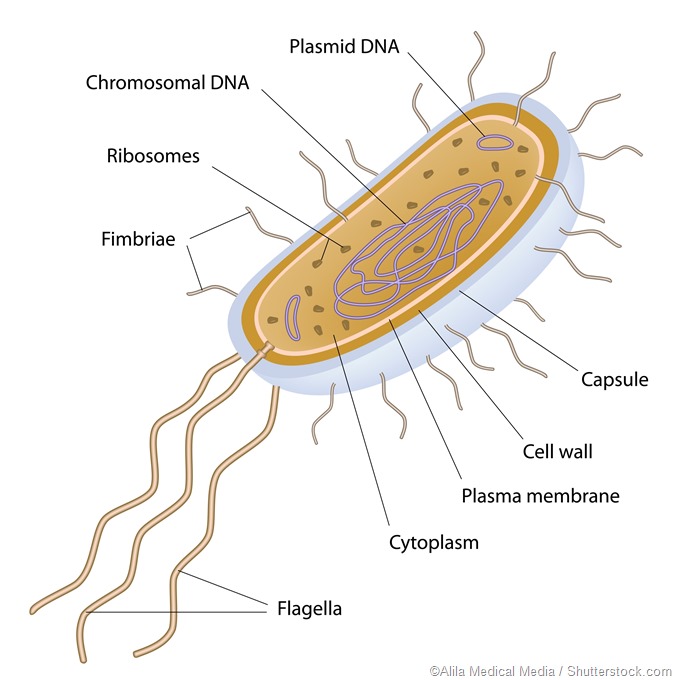
Prokaryotes were the first kind of organisms to evolve. They are single-celled organisms that don’t have a well-defined nucleus and also lack other membrane-bound organelles such as mitochondria. The genetic material in prokaryotic cells exists within an irregularly shaped area of the cell known as the nucleoid.

All water-soluble components within prokaryotes such as DNA, proteins and metabolites are found in the cytoplasm, enclosed within the cell membrane and not in separate compartments of the cell. However, bacteria have protein-based micro-compartments that behave like basic organelles within protein shells.
Structure of prokaryotic cells
The two types of prokaryotic cell are Archaea and bacteria. Prokaryotes have a cytoplasm, plasma membrane, DNA, and ribosomes, but no nucleus. They have a cell wall that offers an additional layer of protection, prevents dehydration and maintains the shape of the cell. The cell wall is made of peptidoglycan. Some prokaryotic cells also have a polysaccharide layer, referred to as a capsule, that enables specific attachment of the cell to certain surfaces.
Prokaryotes have a plasma membrane, which separates intracellular components from the external environment. Prokaryotic cytoplasm is made up of a jelly-like substance called the cytosol, in which cell components are contained.
As is the case for all cells, bacteria have a cytoskeleton, a network of filaments and tubules that provides structural support and maintains the shape of the cell. The cytoskeleton also forms a whip-like, external structure called the flagella, which the cell uses to move from one place to another (locomotion). Thin, hair- like structures called pili are also found in some bacteria, which aid in adhesion to other bacteria or host cells.
Some prokaryotes have intracellular membranes such as vacuoles or other systems with specific metabolic properties and play a role in processes such as chemolithotrophy or photosynthesis. Some species have carboxysomes or gas vacuoles in the cell, which are carbohydrate-containing micro-compartments that play distinct physiological roles.
Characteristics of prokaryotic cells
The size and shape of prokaryotic cells are described below:
Size
The majority of prokaryotes are between 1 and 10 µm in diameter, although they can reach sizes of up to 750 µm. For example, Thiomargarita namibiensis, a gram-negative Proteobacterium, typically ranges in size from 100 to 300 µm in diameter, but can be as large as 750 µm. It is the largest bacteria discovered to date. The tiny size of prokaryotes aids the rapid entry and diffusion of nutrients to all cell parts and also allows quick elimination of waste from the cell.
Shape
Prokaryotic bacteria form multiple shapes, the main ones being rod-shaped (baccilli), spiral-shaped (spirochete) and spherical-shaped (cocci). Cocci may appear elongated, oval or flattened. They can be classified into diplococcic, streptococci, tetrads, sarcina and staphylococci, based on their structure and appearance after cell division. The rod-shaped bacteria, bacilli, are further classified into diplobacilli, streptobacilli, and coccobacillus based on how they appear post cell division. Spiral bacteria may be curved rods (vibrios), rigid and helical shapes (spirilla), or flexible, helical shapes (spirochetes).
Archaea
Archaea are single-celled microbes that were initially classified as bacteria and called archaebacteria. Later, it was found that archaea have unique properties that differentiate them from bacteria and eukaryotes.
Although similar in shape and size to bacteria, archaea have genes and metabolic pathways that are more similar to those of eukaryotes. Other biochemical aspects of archaea such as their dependence on ether lipids in the cell membranes are unique. Reproduction in archaea is asexual and achieved through fragmentation, binary fission or budding.
Archaea are abundant in oceans. They are thought to play key roles in the carbon cycle and nitrogen cycle. One example of useful archaea is methanogens, which are found in the human gut, where they aid digestion. Another example is extremophile archaea, which have enzymes that are used in biotechnology on account of their ability to withstand extremely high temperatures.
References
- http://www.ck12.org/biology/Prokaryotic-and-Eukaryotic-Cells/lesson/Prokaryotic-and-Eukaryotic-Cells/
- http://www.biology.arizona.edu/cell_bio/tutorials/pev/page2.html
- http://classes.midlandstech.edu/carterp/courses/bio225/chap04/lecture2.htm
Further Reading
- All Cell Content
- Structure and Function of the Cell Nucleus
- What Are Organelles?
- Cilia and Flagella in Eukaryotes
- Mitosis vs Meiosis
Last Updated: Feb 26, 2019

Written by
Susha Cheriyedath
Susha has a Bachelor of Science (B.Sc.) degree in Chemistry and Master of Science (M.Sc) degree in Biochemistry from the University of Calicut, India. She always had a keen interest in medical and health science. As part of her masters degree, she specialized in Biochemistry, with an emphasis on Microbiology, Physiology, Biotechnology, and Nutrition. In her spare time, she loves to cook up a storm in the kitchen with her super-messy baking experiments.
Source: Read Full Article